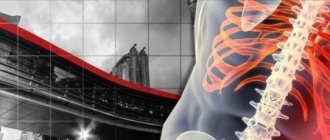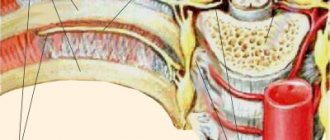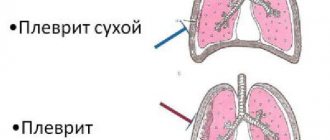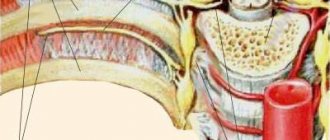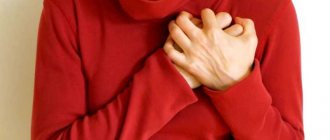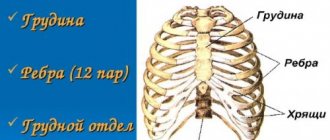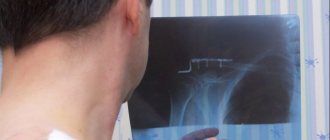In the early stages of the pandemic, it was believed that the main signs of coronavirus infection were only high fever and a dry, intense cough. Observations of patients have shown that there are much more symptoms, and much depends on the general condition of the patient’s body and concomitant diseases. A feeling of tightness in the chest during Covid is common - doctors note that this symptom usually appears in patients with pathologies of the respiratory organs.
Causes related to heart disease
Cardiac discomfort always causes concern, especially if it is pain of a pressing nature. The heart is not always the cause of poor health; there are other triggers for chest pain, but still, cardiac origin is the most dangerous for both men and women of different age categories.
Angina pectoris
This is a type of chronic coronary insufficiency, which provokes cardiac ischemia with changes in tissue trophism. Each attack of angina pectoris begins with chest pain of a pressing or bursting nature, radiating to the shoulder, under the shoulder blade, and back. The most common causes of an attack are physical exertion or stress.
Myocardial infarction
The spontaneous result of one of the attacks of angina pectoris becomes AMI: pain compresses the chest, shortness of breath, general weakness, drowsiness, and a feeling of faintness appear. The reasons are the same, but if this condition is left unattended, death is possible due to myocardial necrosis.
Inflammatory myocardial disorders
This option is rare. An acute change in the condition of cardiac tissue is possible against the background of severe infections, and the root cause is a common cold or bacterial infection of the nasopharynx.
Pericarditis
Inflammation of the outer lining of the heart can manifest itself as pressing pain behind the sternum. The pericardium becomes overfilled with inflammatory exudate with shortness of breath, fever, weakness, and arrhythmia. The trigger is an infection, the consequences of which are extremely serious. As soon as the external pressure of the pericardium on the heart muscle exceeds the level of myocardial resistance, the heart will stop.
Ischemia without other visible symptoms
This is the name given to the condition after a heart attack or myocarditis, and is also typical for older people. The essence is constant insufficient nutrition of the heart muscle with the development of severe ischemia. It is not easy to detect the disease in time. Symptoms appear gradually. Pain behind the sternum is a signal from nerve endings about hypoxia.
Aortic aneurysm
One of the most serious heart pathologies, the only symptom of which can only be a retrosternal heaviness of an unclear nature. The aorta is the largest vessel in the human body, that is, its dissection (aneurysm) is a common cause of death due to rupture of the altered artery wall against the background of atherosclerosis, inflammation, and infection. The essence is a violation of blood circulation. Pain indicates that a catastrophe has already occurred and is accompanied by impaired consciousness and neurological symptoms. The cause may be physical overexertion, stress, or alcohol abuse. To prevent this from happening, it is reasonable to do an MRI at the first chest symptoms and undergo the necessary course of therapy.
When should you call an ambulance?
You will need an ambulance if:
- Along with pain in the chest, there are: a feeling of pressure, compression under the sternum, shortness of breath and irradiation to the left arm, lower jaw and scapula;
- present: nausea, dizziness, palpitations, gray skin, cold sweat, drop in blood pressure, weak thread-like pulse, lack of air and loss of consciousness;
- there is no improvement in the condition after taking nitroglycerin, and the duration of pain is more than 20 minutes. This may include chills, a cough with yellow-green mucus, difficulty swallowing, and persistent chest pain.
Causes associated with lung pathologies
A large group of pathologies that provoke chest pain of a pressing nature are respiratory disorders.
Pneumonia
Acute pneumonia of viral, bacterial, fungal origin, one of the main symptoms of which is heaviness behind the chest in the middle, shortness of breath, a lump in the throat, caused by tissue swelling due to inflammation. The main symptoms include temperature, any effort aggravates chest pain, intoxication, cephalalgia, and heaviness in the legs. The pathology is treated with antibiotics with a preliminary determination of the sensitivity of pathogens to them or with antiviral agents, bronchodilators, and corticosteroids.
Bronchitis
Bronchitis is a variant of inflammation when the lung tissue is not involved in the pathological process. Pressure in the chest due to a strong cough - the body is trying to free the alveoli from viscous secretions and restore normal functioning of the bronchi. Treatment is similar to pneumonia.
Bronchial spasm
The condition develops suddenly and is usually autoimmune or allergic in nature. The attack is accompanied by suffocation, coughing, a lump in the throat, and fainting. Pressing heaviness in the chest occurs due to tissue hypoxia and ischemia. Symptoms are relieved with bronchodilators: Berodual, Berotek.
Lung abscess
This is purulent inflammation in the lung tissue. Pain occurs in the part of the chest where an abscess is forming or has already formed. The temperature always rises, signs of intoxication appear, and there is a risk of developing sepsis. Treatment is antibacterial.
Other inflammatory conditions
This includes pleurisy, pulmonary embolism, blockage of a large vessel - acute conditions that can cause death. Pressing pain in the middle of the sternum – ischemia with rapidly developing pulmonary edema. If pleurisy develops gradually, the symptoms of the pathology resemble pneumonia or ARVI: cough, shortness of breath, fever, headache.
Pressing pain on the left
If you feel pressing pain in the left side of the chest, you should consult a doctor without delay.
The main reasons for its development:
- Aortic aneurysm. A very serious illness. There is an accumulation of blood in the vessel as a result of the fact that their membranes are stratified.
- Myocardial infarction or angina attack . The condition requires immediate hospitalization. Pain in this condition indicates a problem with a large muscle.
- Stomach ulcer. Pain occurs after eating. Often, a regular antispasmodic drug (no-spa) can alleviate a person’s condition.
- Inflammatory process in the pancreas (pancreatitis) . Pain in this organ is projected onto the left side of the chest and is severe. In most cases, discomfort is caused by eating.
- Hernia in the diaphragm. This pathology occurs due to prolapse of intestinal loops through weakened areas in the diaphragm into the chest cavity. As a result, the patient finds it very difficult to breathe.
In this article, we have already discussed in detail the issue of what may hurt in the left side.
Neurological causes
This is the third large group of disorders that cause chest pain. The cause may be hypothermia with the development of neuritis, infection, stress.
Intercostal neuralgia
Recurrent, extremely painful condition with severe chest pain. The pathology is reminiscent of AMI in all its symptoms; a distinctive feature is lumbago with any change in body position or sudden movement. The feeling of tightness in the chest is the result of excessive stimulation of nerve receptors in the periphery.
Intercostal neoplasms
They are rare, benign, mostly neuromas. The cause is a genetic predisposition, the symptoms are similar to neuralgia. Pressure in the chest due to compression of the receptors by neoplasms. The peculiarity is pain in one point.
Osteochondrosis
Pain and compression in the chest due to osteochondrosis. The essence is degeneration of intervertebral discs, compression of spinal roots, development of neurological symptoms. Feature – increased pain when breathing. Osteochondrosis without treatment is the cause of intervertebral hernias and early disability.
Pathologies of the spinal column
Spinal pathologies:
- Osteochondrosis. When the vertebrae are displaced or deformed, pain appears when breathing. They can cause such torment that the patient is forced to remain in one position.
- Costal chondritis (Tietze syndrome) is an inflammation of the cartilage of the ribs at the edge of the sternum. Develops after injuries, strong blows; dull pain in the chest when breathing, intensifies with the depth of inspiration, upon palpation, fever and cough are possible.
- Ankylosing spondylitis. Calcium salts accumulate in the ligaments of the spinal column, they destroy nerve endings; The pain here is lifelong, accompanied by shortness of breath.
- Scheuermann-Mau disease. 1 person out of 100 is sick; pathology begins in adolescence. Leads to the development of kyphosis. The pain is localized between the shoulder blades and appears on inspiration.
- Osteoporosis – calcium deficiency in the bones; At the same time, osteoblasts do not absorb calcium, and it is not integrated into the voids of the bones. The entire spine suffers, it is bent, posture is disturbed, and moderate pain is observed in the thoracic spine when inhaling. Movements are limited due to the fact that the pain intensifies with them. There is also numbness in the limbs and painful asymmetrical points on palpation.
Other diseases when the chest is compressed
There is a group of diseases that stand alone:
- pathology of the thyroid gland: the cause of pain behind the sternum is compression of the neck tissue by the growing gland;
- throat diseases cause local swelling and pain behind the sternum at this level (pharyngitis, laryngitis, tracheitis);
- curvature of the spine - the cause of pressing pain in the middle of the sternum - kyphoscoliosis with deformation of the chest;
- esophagitis: the cause of pain and pressure in the chest can be pathologies of the digestive system, in particular gastroesophageal reflux disease (GERD) or reflux esophagitis, when the muscles of the esophageal sphincter weaken and reverse reflux of food occurs; esophagitis often occurs in smokers and coffee drinkers and alcohol;
- allergies - a lump in the throat, shortness of breath - the first symptoms of angioedema, a response to allergy products, medications, which is life-threatening and requires emergency measures;
- injuries – pain behind the sternum at the level of the throat, if it is damaged by hard, sharp objects, as a result of a burn, broken ribs, tracheal injuries;
- tumors of the ENT organs of various origins are sometimes also accompanied by a lump in the throat.
Why is there pressure in the chest during pregnancy?
During pregnancy, a woman often experiences unpleasant sensations in the form of compression and pain in the chest, difficulty breathing. Of course, this could be any of the diseases we have listed, but there are also typical causes of chest pressure that are characteristic of gestation. Most often, this is the second trimester, when the uterus is actively growing and begins to put pressure on all nearby organs, propping up the diaphragm, causing chest discomfort.
In addition, the cause of pain can be changes in hormonal levels. During preparation for delivery, the concentration of relaxin increases, which makes the ligaments and tendons more elastic so that the fetus passes through the birth canal more easily. But the same hormone also acts on the ligaments of the chest, causing a feeling of fullness and discomfort. After giving birth, everything returns to normal.
Pregnant women are also bothered by heartburn, which causes the chest to not only press, but burn. This condition is also provoked by an enlarged uterus, which puts pressure on the stomach, displacing it upward, preventing the esophageal sphincter from closing.
Classification of pain sensations
Chest pain when inhaling is divided according to localization, severity, intensity, duration, etc., they occur from the neck to the abdomen. It is most convenient to consider them by location: right and left sides, as well as in the center - to narrow the search for the cause:
- In the middle - then we can assume damage to the diaphragm, heart, esophagus and lungs.
- On the right - the cause may be rib injuries, sore throat, CVD, gastrointestinal tract, respiratory infections and oncology.
- On the left - CVD, tumors and pleurisy, trauma, renal colic, inflammation of the pleura.
